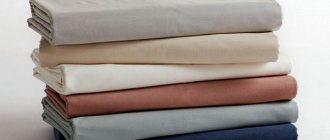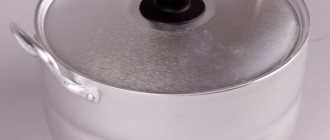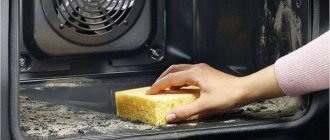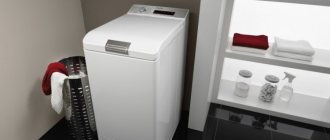In what container is it better to cook jam so that it turns out tasty, healthy and can be stored for a long time? To solve this problem, manufacturers produce a wide range of cookware every day.
Kitchen utensils for such purposes vary in size, shape and raw materials. To figure out which model to choose, we recommend that you familiarize yourself with the listed parameters in more detail.
We choose in which container to cook the jam.
Pan or basin
The type of container is selected taking into account the number of berries and fruits that the consumer plans to prepare for a long or short term. The same can be said about the volume of the product.
If you decide to make jam from 1-2 kilograms of berries, then it is preferable to use a saucepan. However, if we are talking about cooking a delicacy from 5-10 kilograms of fruits or berries, then you cannot do without a massive basin.
The basin is used when making jam from 5-10 kilograms of fruits or berries.
Review of products from online stores
This short review will help you get a good idea of what the utensils for home-made jams, marmalades, confitures and other fruit and berry sweets for the winter look like.
The stainless steel jam bowl from the French company Mauviel has a bottom diameter of 36 cm, which is ideal for the home kitchen oven. The height of the walls is 12 cm. The inner surface is matte, the outer surface is mirrored. Two comfortable handles. The dish is ideal for jam from cherries, cranberries, currants and other sour berries.
A copper basin with a volume of 4.5 liters is suitable for small portions of fruit and berry preparations. The bottom of the pan is smaller than the diameter of the top, which speeds up boiling, but requires stirring.
The inexpensive Kalitva jam bowl from a domestic manufacturer is made of aluminum. Suitable for quick one-step cooking. Best used for sweet fruits. Volume – 12 liters. Convenient for preparing fruits - washing, cutting, sorting the crop. The large bottom diameter is not suitable for all slabs!
A 3-liter brass basin with a removable wooden handle is suitable for home cooking on any stove except induction. The long handle is convenient for shaking the contents so that the syrup evenly covers the pieces of fruit and berries.
Be sure to check the cost of goods in different stores. Even products with the same article number may have different prices. Products from European manufacturers are always more expensive than domestic and Asian ones. Russian brands have many good offers.
There is no point in buying a special basin if you plan to prepare it once. Using the theoretical knowledge you have acquired, choose in which container it is better to cook the jam from the existing one.
Preferred container sizes
The size of the container is selected taking into account the number of household members or the desired volume of the prepared mass. If you want to make jam for quick consumption, use a small cauldron. In addition, it will not take long to wash it.
If you decide to stock up on such a delicacy for the winter and pour it into jars, give preference to massive containers. It’s a little harder to wash, but you won’t regret it later.
It is believed that jam turns out better in a wide and shallow container.
Main advantages and benefits
Surely many housewives have already appreciated the lightness of this kitchen utensil. Its second advantage is practicality and ease of use. Cookware made of aluminum alloys has high thermal conductivity. It heats up much faster than similar products made of stainless steel. It is also worth noting the corrosion resistance, which is a big advantage considering the purpose of the cookware. If you follow all the rules of use correctly, aluminum kitchen utensils will last a long time.
This is interesting: In terms of thermal conductivity and quality, aluminum ranks second. The only thing better than copper is copper.
Materials used to make such pans
When buying containers for making jam, it is imperative to take into account the raw materials from which the product is made. This is due to the fact that there are a lot of recipes for jam and marmalade. Some require several stages of cooking, while others, on the contrary, can be prepared in an hour.
Focus on this parameter so that you don’t end up having to expose the dishes to temperature fluctuations. Because some metal products lose performance from sudden thermal influences.
Stainless steel jam utensils have good technical characteristics.
Stainless steel
Stainless steel jam utensils are considered the most optimal container option, as they have good technical characteristics. Steel is not subject to corrosion, mechanical damage and oxidation, which is very important when cooking. Since steel pans do not react with acids, you can cook sweet and sour berries in them: cherries, currants, etc.
Glossy and matte products are produced from stainless steel. This design fact does not affect the quality of the prepared food in any way. Which of the vessel options to choose is up to the buyer to decide for himself.
During the washing process, drops of water remain on the shiny surface, which must be removed immediately to avoid stains.
As for the thickness of the walls and bottom, you should choose thick-walled structures. The presence of a dense bottom allows you to cook fruit for a long time.
It is prohibited to store cooked foods in an aluminum pan for a long time.
If there is no steel cookware: aluminum or copper
If you don’t have steel containers at hand, then utensils for making jam made from aluminum and copper are suitable. Both metals have individual characteristics and advantages, which we will discuss below.
Let's consider the main advantages of copper structures:
- The metal is characterized by a high level of thermal conductivity. In a few minutes, kitchen utensils can both cool down and heat up.
- Temperature control is easy due to thermal conductivity.
- Copper has excellent antifungal and antibacterial properties. Even without heating the dishes, the risk of infection by pathogenic bacteria and viruses is minimal.
Nowadays, copper structures are used less and less during the cooking process. This lack of demand is due to the fact that the metal oxidizes during operation. Harmful chemicals can get into food and have negative effects on the human body.
Cooking in a copper pot will require less energy.
In order to minimize the risk of oxidation, the products are coated with tin. Despite the fact that the coating is considered protective, metal utensils require careful care.
Although aluminum alloy cookware cannot be used for making jam, some consumers take the risk. However, during operation they cannot do without certain rules:
- Boil sweet fruits, without sourness, if you choose aluminum containers.
- Use the product on the stove, having previously placed the berries in it and covered them with sugar.
- Stir the jam from time to time with a wooden spatula so that it does not stick to the walls and bottom of the dish.
- Use instant recipes.
It is prohibited to store cooked foods in an aluminum pan for a long time. After completing the cooking process, immediately pour the mixture into a separate bowl or distribute into jars.
Enameled pans should absolutely not be used for cooking jam.
Enameled utensils for making jam
Enameled pans should absolutely not be used for cooking jam. But what to do if there are simply no other dishes? As a possible option, you can use an enamel basin, if you follow some operating nuances:
- Cook over low heat.
- Stir the mixture constantly to prevent it from burning.
- Use silicone spatulas for stirring.
If you are convinced that you cannot follow simple rules, then use an enamel structure for pre-processing berries and fruits. You can store sugar-covered foods in such a container for a long time.
If chips, microcracks or scratches are found on an enamel pan, you should not use it in the future.
Enamel is often applied to cast iron and steel products. Cast iron is more suitable for cooking sweet syrups and jams, as it has natural non-stick properties.
Cast iron is perfect for making jam.
Cast iron
As mentioned earlier, cast iron is perfect for making jam, if all precautions are taken. Have you decided to make jam in a cast iron cauldron? After cooking, do not forget to pour the mixture into glass or enamel containers.
And also do not overuse the preparation of acidic foods in cast iron structures. When reacting with acids, cast iron releases harmful substances.
All consumers prefer kitchen utensils with non-stick coating.
Non-stick cookware
All consumers prefer kitchen utensils with non-stick coating. Moreover, its variety is quite wide: Teflon, titanium, ceramics and marble. Each of them has features and advantages.
As you know, there are no specialized utensils for cooking jams and syrups, so housewives often use multicookers. However, there are nuances here too:
- Use only non-metallic ladles to pour the mixture into jars.
- The non-stick coating is not resistant to sudden temperature changes.
- Not every coating is suitable for leaving the mixture to sit.
Experts recommend focusing on models suitable for quickly preparing jam and other sweets. And also choose an oversized design.
As experts say, the most wear-resistant protective coating is ceramic. It can withstand temperatures up to 400 degrees. The non-stick ceramic layer requires prompt maintenance.
Modern utensils for jam, which is better: Teflon or ceramic
When using utensils for cooking syrups and jams, it should be taken into account that the non-stick layer does not protect the food, but the structure itself. Which spraying should you prefer? Of course, if you choose from tetrafluoroethylene and ceramics, then the second option is most suitable for this purpose.
However, do not forget that with the slightest flaw in the container body, it becomes dangerous for use. Try to avoid using sharp objects while cooking.
Ceramic dishes should be washed in warm water using dishwashing detergents.
How to prevent sweets from burning
To get the perfect jam, it is necessary not only to correctly select the raw materials and containers used for it, but also to observe an important condition - careful control over the process. The most common problem is burning of the contents. As a result, the sweetness will smell unpleasant and taste bitter.
Tip : You can get rid of the burnt taste by boiling the dessert in a separate clean container with the addition of any of the following products: lemon juice or acid, cinnamon, cognac, orange or lemon zest.
There are several cooking rules that are worth the attention of not only beginners, but also more experienced cooks.
- Give preference not to a saucepan with handles, no matter how convenient it may be. The best option is a wide basin with low walls. It may seem like a bad choice because it takes up most of the cooking surface. However, it is in the basin that the mass warms up evenly.
- Pay attention to the fire level under the cookware. It should not “lick” the walls of the container, but only heat the bottom.
- After the contents boil, set the burner flame control to medium. Ideally, the workpiece should be boiled over low heat for the first ten minutes.
- Stir throughout the entire thickness of the jam. The spatula or spoon, depending on what you use, should reach the bottom. Thus, berries or fruits will not stick to the basin and, as a result, burn.
- Observe the proportions of the ingredients. For one kilogram of berries, you need to add a similar volume of granulated sugar. And its excess can lead to irreparable results.
- Skim off foam regularly.
- Take your time to turn on the heat under the pan. Let the berries or fruits release their juice combined with sugar. Start cooking only when the sand is almost completely dissolved.
Advice : it is quite possible to save the situation if you did not take care of the jam and it burned, but only if the problem is detected in a timely manner. To do this, you need to pour the sweet mass into another clean container and continue cooking.
Utensil shape for making jam
Wide containers with low sides are considered suitable for making jam. The liquid in it evaporates very quickly and the mass begins to thicken in a matter of minutes.
That is why many people prefer medium-sized basins. Their massive, flat bottom warms up evenly. This way, all the berries can be cooked until tender.
Designs with a thin bottom cannot be used for making jam.
Selection rules
To find out which utensils are suitable for making jam, you need to decide on the raw materials and volumes of the workpiece. Carefully familiarize yourself with the properties of materials for making cookware. It is also worth considering the capabilities of your home stove.
Depending on the plate
For a gas stove, it is necessary to use dishes with a thick bottom and walls, otherwise the jam will cook unevenly due to open fire. The cookware should distribute the temperature evenly on its own. In this case, stainless steel containers are suitable. Do not use glass or ceramic dishes, as the product may burst. Or you need to purchase a divider.
On a glass-ceramic stove, you need to use dishes with a bottom diameter the same as the diameter of the burner; minor deviations are possible. Here it is better to use glass or ceramic dishes with a flat bottom.
Induction cookers require special cookware. Most often these are stainless steel containers. To make jam, you can choose a stainless steel bowl.
For glass ceramics
For gas
For induction cookers
Utensil shape
Utensils of any shape are suitable for making jam, but preference is given to a low container with a large diameter bottom and a wide open top. It is most practical to use a basin. The water evaporates well in it, thanks to the large bottom area, and the jam is boiled evenly. The most optimal sizes: bottom diameter - from 36 to 40 cm and wall height from 10 to 15 cm.
Diameter - 40 cm. Wall height - 10 cm
Suitable size and volume
For a family of four, 20 liters of jam of different flavors will be enough for a year. It is better to put it in small 0.5 liter jars. If you plan to use the product soon, the jars can be closed with regular plastic lids. For longer storage, metal screw caps should be used. This delicacy can be served as a dessert with tea, or used for baking and jelly.
Which basins and pans are unsuitable for making jam?
Avoid using narrow, tall pans. You will not be able to prepare jam according to the recipe in them, since the moisture evaporates slowly and incompletely.
Designs with a thin bottom also cannot be used, since the sugar mass can burn, even if you cook on low heat. In addition to the thickness of the bottom, consider its shape - it must be perfectly flat and smooth for uniform heating.
After preparing the jam, the pan must be thoroughly washed.
What is the possible harm?
The main disadvantage of aluminum cookware is that this metal can react with some products. As a result, dangerous compounds are formed that harm the human body. It is not advisable to store food in such containers. After cooking, it is recommended to immediately transfer them to safer containers. Surely many, due to their inexperience and lack of knowledge, tried to whip the cream in an aluminum bowl, as a result of which they observed how it acquired a gray tint and a metallic taste.
After prolonged use, the appearance of kitchen utensils made of such metal deteriorates. Dark spots, dents, scratches and other consequences of improper use and mechanical stress appear. Gradually, food can etch metal from the bottom and sides of the cookware, causing the dish to burn and heating to become uneven. Of course, such qualities do not decorate aluminum kitchen utensils, but the low cost for most housewives is too great a temptation to refuse such an acquisition.
This is interesting: Several decades ago, scientists conducted studies that showed that people who use only aluminum cookware are more likely to develop Alzheimer's disease. True, modern experiments do not confirm this.
Recommendations for caring for dishes
After preparing berry or fruit jam, the pan must be thoroughly washed. But since structures made from different materials are used for cooking, the rules for care also vary. We have put together some general recommendations that are suitable for any type of kitchen utensil.
- Use cleaning products that contain acid or alkali less often. Ideally, it is better to completely eliminate their use.
- Do not wash dishes in the dishwasher as they may be seriously damaged and deformed.
- Wipe items dry.
- Do not use hard metal scrapers. They provoke the occurrence of microcracks.
- Powder compositions are not recommended for use when cleaning kitchen utensils.
To wash metal utensils that are unstable to sudden temperature changes, it is recommended to first cool the structure. Then gradually pour in water, increasing its temperature. This way it will be easy to remove the remaining sugar and syrup from the walls of the cauldron or basin.
Production technology
Ready-made aluminum sheets are used to make cookware. Subsequently, through mechanical processing, certain items of kitchen utensils are stamped from them. In this case, the method of coining is used (the product is extruded from a single sheet) or forging (processing under pressure using special forging hammers or a press). Of course, when buying aluminum cookware, few people pay attention to the issue of its production, but it is worth noting that products obtained as a result of forging have greater thermal conductivity and strength.
Cookware made of cast aluminum is not only very popular, but also relatively high in cost. The thing is that to manufacture products in this way, the manufacturer uses high-quality material, which is poured into pre-prepared molds. This technology differs from stamping in that the metal is not subject to deformation, maintaining its physical properties.
Production of tableware from finished aluminum sheets
This is interesting: Recently, manufacturers often use the technology of thickening aluminum. Dishes made in this way are comparable in many respects to products made from cast aluminum, so an inexperienced consumer is unlikely to notice the difference.
Video about the production of kitchen utensils from this material
Proper Use
If you adhere to all the requirements that apply to this type of metal, and also take care when using it, aluminum cookware can last a very long time. Thus, it’s worth figuring out what you can cook in it so as not to harm yourself and your loved ones.
What kind of food can you cook?
In aluminum cookware you can cook dishes that do not contain large amounts of acids. These products include:
You can fry cutlets or scrambled eggs in an aluminum frying pan. But it must be remembered that after preparing the dish, it should be immediately transferred to porcelain, earthenware or glassware. If this is not done, the food, as well as the hostess’s mood, will be ruined. The dish will lose its color, taste and benefits, and loved ones will not be able to appreciate it.
Potatoes in an aluminum frying pan come out fried
Is it possible to cook sour dishes?
In the process of preparing dishes from foods that contain large amounts of acids and salts in such dishes, metal is released into the food. This harms the human body. Therefore, you cannot cook sour dishes in aluminum cookware. Examples include:
- pickle;
- compote;
- cabbage soup and others.
Is it harmful to salt foods?
If you pickle cabbage or cucumbers in an aluminum pan, nothing good will come of it. The protective film that covers aluminum will be destroyed under the influence of acids, the product will change its taste not for the better and will become harmful to humans. It is better to salt the cucumbers in another container.
Is it worth cooking jam and marinades in it?
Cooking jam in aluminum containers is not recommended. And the reason for this, as in the previous case, is that berries and fruits contain acids. As a result, particles of aluminum with jam will enter the human body. However, in berries and fruits there is not such a large amount of acids as, for example, in the brine of cucumbers or cabbage. Therefore, some experts are of the opinion that it is still possible to cook jam in such a container, only after that it is necessary to immediately transfer it to a safer container.











